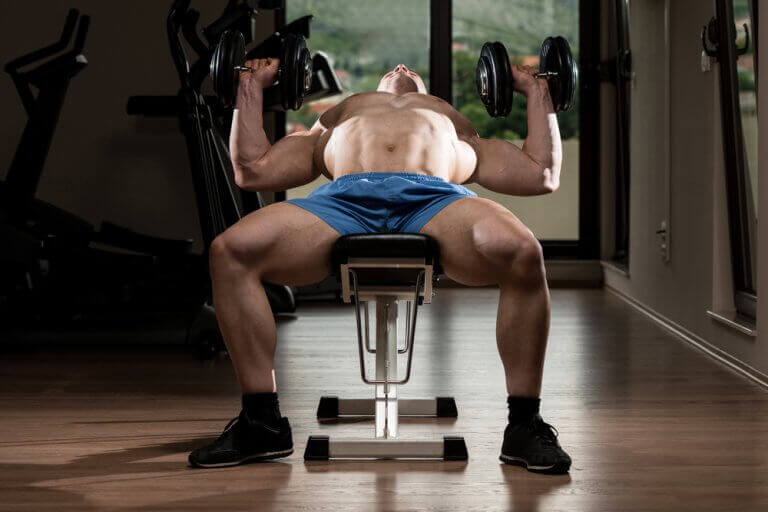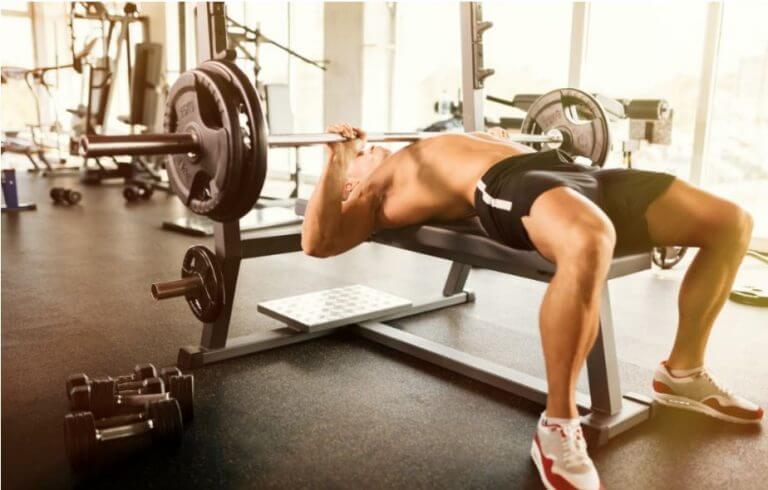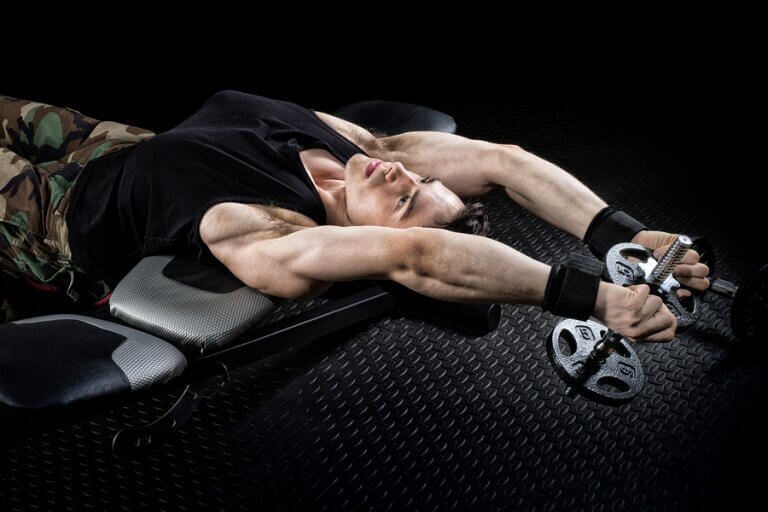Exercises to Work the Chest Muscles

The chest is one of the body areas that fitness addicts enjoy working on the most. However, athletes don’t always perform the ideal exercises to ensure proper muscle development. For this reason, we want to talk about the best exercises to work the chest muscles.
In the first place, the chest consists of two muscles that work together to allow all of its functions. These muscles are the major pectoral and minor pectoral.
You can work both of them in the gym. However, you have to ensure that you perform all of the movements perfectly, and avoid falling into bad habits that lead to a lack of progress or, even worse, future injuries.
Likewise, it’s very important to set apart enough time to do a good warm-up before all of your workouts. This minimizes the risk of suffering from a muscle injury and helps to activate the main pectoral muscles.
The best exercises to work the chest muscles
1. Incline bench chest press
To perform this chest press, you have to lie down on an incline bench holding a dumbbell in each hand. Then, lift the dumbbells up to your shoulders. With your arms extended, twist your wrists so that the palms of your hands are facing each other.
During the exercise, you must try to keep the dumbbells under control at all times. Lower them slowly while you inhale. Finally, exhale while pushing them up with the help of your chest muscles.

2. Bench press
The bench press is one of the most preferred exercises among athletes that regularly work out at the gym. To perform it, you have to stretch your back on a bench and completely support your torso from the head to your hips. Keep your knees bent and your feet behind the cushion of the rods.
Then, hold on to the bar with a wide and spacious grip. Bend your arms and lower the bar slowly towards the bottom part of your chest. When it reaches chest level, extend your arms outward, elevating the bar to the original position.

3. Dumbbell pullover
Besides the previous exercises, the dumbbell pullover is another ideal movement to work the chest muscles. To do it, lie on a bench that supports the upper part of your back, head, and neck. Your feet should remain relaxed on the floor. Hold a dumbbell with your arms extended over your head.
With only a slight curve in your elbow, lower the dumbbell back slowly, allowing your elbows to reach a point in which they become aligned with your ears. Then, invert the direction and bring the dumbbell back over.

4. Push-ups, indispensable movements to work the chest muscles
The last movement we’ll cover is the push-up. This classic bodyweight exercise is great to start and maintain as a basic element in a chest training routine.
To do a push-up, lie down on your abdomen and use your hands as a support to hold up your torso with the arms extended. Then, lower your body until it almost touches the floor. Once you’re there, return to the initial position by pushing back.
After a brief pause in the starting position, you can start to go down again. Do as many reps as you need. If you’re a beginner, you can do push-ups by leaning your feet against the wall instead of using the floor as support.
Finally, remember that any of these exercises require you to previously stretch the chest muscles to boost your performance and decrease the risk of injury. Now that you know the best exercises to work the chest muscles, it’s time to choose your favorite ones and get down to business!
The chest is one of the body areas that fitness addicts enjoy working on the most. However, athletes don’t always perform the ideal exercises to ensure proper muscle development. For this reason, we want to talk about the best exercises to work the chest muscles.
In the first place, the chest consists of two muscles that work together to allow all of its functions. These muscles are the major pectoral and minor pectoral.
You can work both of them in the gym. However, you have to ensure that you perform all of the movements perfectly, and avoid falling into bad habits that lead to a lack of progress or, even worse, future injuries.
Likewise, it’s very important to set apart enough time to do a good warm-up before all of your workouts. This minimizes the risk of suffering from a muscle injury and helps to activate the main pectoral muscles.
The best exercises to work the chest muscles
1. Incline bench chest press
To perform this chest press, you have to lie down on an incline bench holding a dumbbell in each hand. Then, lift the dumbbells up to your shoulders. With your arms extended, twist your wrists so that the palms of your hands are facing each other.
During the exercise, you must try to keep the dumbbells under control at all times. Lower them slowly while you inhale. Finally, exhale while pushing them up with the help of your chest muscles.

2. Bench press
The bench press is one of the most preferred exercises among athletes that regularly work out at the gym. To perform it, you have to stretch your back on a bench and completely support your torso from the head to your hips. Keep your knees bent and your feet behind the cushion of the rods.
Then, hold on to the bar with a wide and spacious grip. Bend your arms and lower the bar slowly towards the bottom part of your chest. When it reaches chest level, extend your arms outward, elevating the bar to the original position.

3. Dumbbell pullover
Besides the previous exercises, the dumbbell pullover is another ideal movement to work the chest muscles. To do it, lie on a bench that supports the upper part of your back, head, and neck. Your feet should remain relaxed on the floor. Hold a dumbbell with your arms extended over your head.
With only a slight curve in your elbow, lower the dumbbell back slowly, allowing your elbows to reach a point in which they become aligned with your ears. Then, invert the direction and bring the dumbbell back over.

4. Push-ups, indispensable movements to work the chest muscles
The last movement we’ll cover is the push-up. This classic bodyweight exercise is great to start and maintain as a basic element in a chest training routine.
To do a push-up, lie down on your abdomen and use your hands as a support to hold up your torso with the arms extended. Then, lower your body until it almost touches the floor. Once you’re there, return to the initial position by pushing back.
After a brief pause in the starting position, you can start to go down again. Do as many reps as you need. If you’re a beginner, you can do push-ups by leaning your feet against the wall instead of using the floor as support.
Finally, remember that any of these exercises require you to previously stretch the chest muscles to boost your performance and decrease the risk of injury. Now that you know the best exercises to work the chest muscles, it’s time to choose your favorite ones and get down to business!
All cited sources were thoroughly reviewed by our team to ensure their quality, reliability, currency, and validity. The bibliography of this article was considered reliable and of academic or scientific accuracy.
- Daniel Vega. 2008. Entrenamiento de hipertrofia para la musculatura pectoral y del hombro. https://www.asesejerciciofisico.com/wp-content/uploads/2012/06/Hombro-y-Pecho.pdf
- Federación Extremeña de Balonmano., Jaimes, M. F., Bautista, I. ., Arguelles, J., Monje, J. M., & Chirosa Ríos, L. J. (2005). Análisis cinético y cinemático del press de banca en dos situaciones de evaluación press banca libre vs press banca máquina smith. Proyecto piloto. E-Balonmano.Com: Revista de Ciencias Del Deporte, ISSN-e 1885-7019, Vol. 8, No. 2, 2012, Págs. 105-120, 8(2), 105–120. Retrieved from https://dialnet.unirioja.es/servlet/articulo?codigo=4373635
This text is provided for informational purposes only and does not replace consultation with a professional. If in doubt, consult your specialist.








